WordPress temanıza sayısal sayfalandırma eklemek mi istiyorsunuz?
Varsayılan olarak, WordPress temaları arşiv sayfalarının altına bir Sonraki / Önceki bağlantıları ekler. Sorun şu ki bunlar pek kullanıcı dostu değil. Bu nedenle birçok popüler blog, ziyaretçilerin arşiv sayfalarında gezinmesini kolaylaştırmak için sayısal sayfalandırma kullanır.
Bu makalede, WordPress temanıza nasıl sayısal sayfalandırma ekleyeceğinizi göstereceğiz.
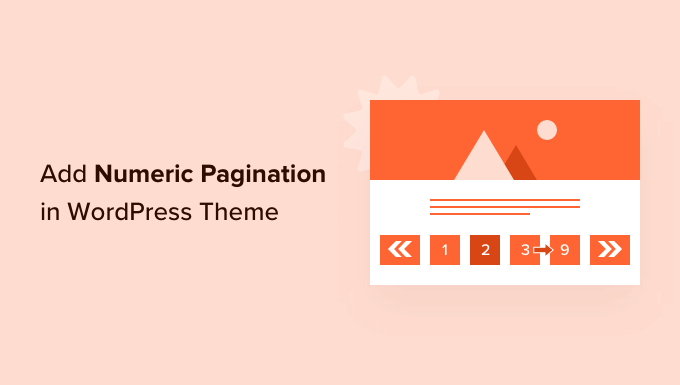
WordPress Temanıza Neden Sayısal Sayfalandırma Eklemelisiniz?
Çoğu temada yazıların listesini gösteren bir arşiv sayfası bulunur. Daha fazla WordPress blog yazısı yayınladıkça, arşiv sayfanız birden fazla sayfaya yayılacaktır.
Sayfalandırma bağlantıları ziyaretçilerin arşiv sayfaları arasında hareket etmesine yardımcı olur ve genellikle WordPress web sitenizin alt kısmında görünür.
Bazı WordPress temaları sayfalama için ‘Eski yazılar’ ve ‘Yeni yazılar’ bağlantılarını kullanır. Ancak bu, ziyaretçinin yalnızca bir sayfa ileri ve geri gitmesini sağlar.
Ayrıca ziyaretçinin arşivdeki mevcut konumunu da göstermez. Bu, ziyaretçilerin blogunuzun arşivinde gezinmesini zorlaştırabilir.
İşte burada sayısal sayfalandırma devreye girer.
‘Daha Eski’ ve ‘Daha Yeni’ bağlantılarını göstermek yerine, sayısal sayfalandırma, ziyaretçilerin arşivdeki belirli bir sayfaya atlamasını sağlayan bir dizi sayı gösterir.
Sayısal sayfalandırma, geçerli sayfa numarasını göstermek için vurgular veya farklı renkler de kullanabilir, böylece ziyaretçi her zaman arşivin tam olarak neresinde olduğunu bilir.
WPBeginner’da sayısal sayfalandırma kullanıyoruz ve mevcut sayfa numarasını turuncu renkle vurguluyoruz. Ayrıca ziyaretçinin mevcut sayfasını çevreleyen 4 sayfaya doğrudan bağlantılar sağlıyoruz.
Aşağıdaki resimde de görebileceğiniz gibi, ziyaretçilerin en eski gönderilerimizi hızlı ve kolay bir şekilde görebilmeleri için arşivimizdeki son sayfaya bir bağlantımız bile var.
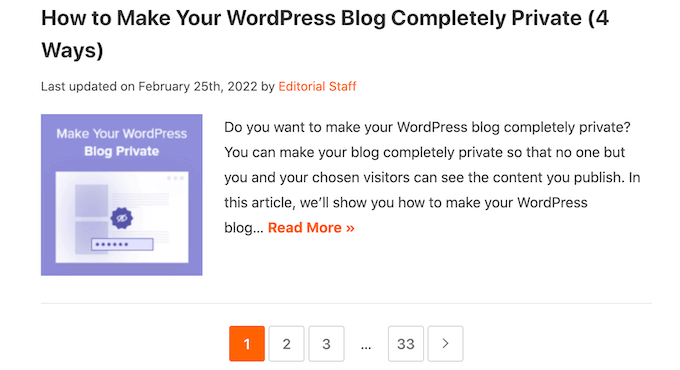
Deneyimlerimize göre, bu tür bir sayısal sayfalandırma, varsayılan ‘Eski yazılar’ ve ‘Yeni yazı’ bağlantılarına kıyasla sitenizde gezinmeyi kolaylaştırır.
WordPress temanızda ‘Daha Eski’ ve ‘Daha Yeni’ sayfalandırması varsa, bunu her zaman sayısal sayfalandırma ile değiştirmenizi öneririz.
Bu kılavuzda, WordPress temanıza sayısal sayfalandırma eklemenin iki farklı yolunu ele alacağız. Doğrudan belirli bir yönteme atlamayı tercih ederseniz, aşağıdaki bağlantıları kullanabilirsiniz.
- Yöntem 1. WP-PageNavi kullanarak WordPress’te sayısal sayfalandırma nasıl eklenir
- Yöntem 2. WordPress temanıza manuel olarak sayısal sayfalandırma nasıl eklenir
Yöntem 1. WP-PageNavi kullanarak WordPress’te Sayısal Sayfalandırma Nasıl Eklenir
WordPress’te sayısal sayfalandırma eklemenin en kolay yolu WP-PageNavi eklentisini kullanmaktır.
Bu eklentiyi kullanmak için temanızın kodunda yine de bazı değişiklikler yapmanız gerekecektir, ancak WP-PageNavi sitenizin sayfalandırması üzerinde tam kontrol sağladığından tam kod yönteminden çok daha kolaydır.
Yapmanız gereken ilk şey WP-PageNavi eklentisini kurmak ve etkinleştirmek. Daha fazla ayrıntı için lütfen bir WordPress eklentisinin nasıl kurulacağına ilişkin adım adım kılavuzumuza bakın.
Eklentiyi etkinleştirdikten sonra, eklenti ayarlarını yapılandırmak için Ayarlar ” PageNavi bölümüne gidin.
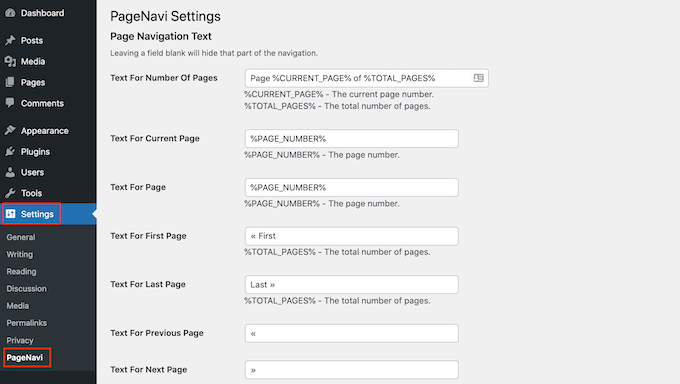
Burada, varsayılan sayfalandırma metinlerinden herhangi birini kendi ifadelerinizle değiştirebilirsiniz. Örneğin, web sitenizin ‘İlk Sayfa’ ve ‘Son Sayfa’ bağlantıları için kullandığı metni değiştirebilirsiniz.
Sayısal sayfalandırma bağlantılarını da özelleştirebilirsiniz.
‘Gösterilecek Sayfa Sayısı’ bölümünde, eklentinin web sitenizin sayfalandırma bölümünde kaç sayfa göstereceğini seçebilirsiniz.
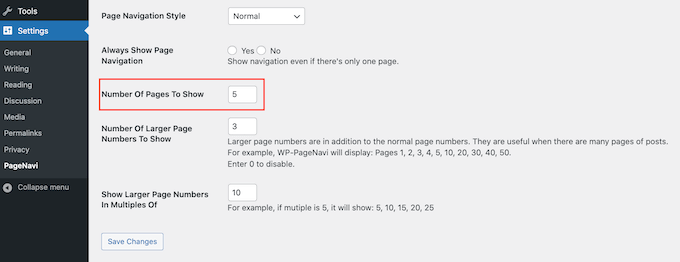
Bu varsayılan olarak 5 olarak ayarlanmıştır, yani WP-PageNavi 5 sayfaya doğrudan bağlantı gösterecektir.
Aşağıdaki ekran görüntüsünde de görebileceğiniz gibi, 4. sayfadaysanız 2, 3, 4, 5 ve 6. sayfalara bağlantılar göreceksiniz.
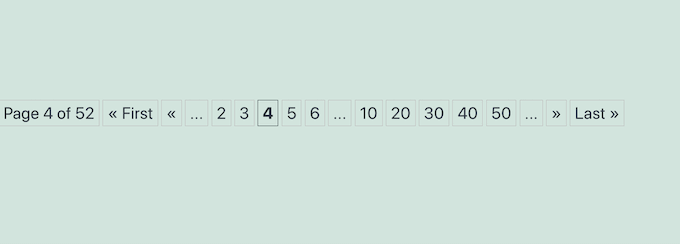
Daha fazla veya daha az sayfa göstermek isteyebilirsiniz. Bu değişikliği yapmak için ‘Gösterilecek Sayfa Sayısı’ alanına yeni sayıyı yazmanız yeterlidir.
Varsayılan olarak, eklenti birkaç büyük sayı gösterecektir. Bu, ziyaretçilerin tek bir tıklamayla birden fazla sayfada ilerlemesini sağlar.
Varsayılan olarak, eklenti her seferinde 10 artan üç büyük sayı gösterir. Örneğin, 10, 20 ve 30.
Farklı bir aralık mı kullanmak istiyorsunuz, örneğin 5 veya 20 gibi? O zaman yeni aralığı ‘Daha Büyük Sayfa Numaralarını Katları Halinde Göster’ alanına yazmanız yeterlidir.

Her WordPress sitesi farklıdır, bu nedenle hangi sayfalama ayarlarının sizin için en iyi sonucu verdiğini görmek için farklı ayarları denemek iyi bir fikirdir.
WP-PageNavi ayarlarında herhangi bir değişiklik yaptıysanız, sayfanın en altına kaydırmayı ve Değişiklikleri Kaydet düğmesine tıklamayı unutmayın.
Ardından, WordPress temanıza bir şablon etiketi eklemeniz gerekir. Bunu yapmak için bir alt tema oluşturmanızı ve ardından alt temanın kodunu düzenlemenizi öneririz.
Bir alt tema oluşturarak, özel sayısal sayfalamanızı kaybetmeden WordPress temanızı güvenli bir şekilde güncelleyebilirsiniz. Daha fazla bilgi edinmek için WordPress alt temasının nasıl oluşturulacağına ilişkin adım adım kılavuzumuza göz atın.
İster ana ister alt temayı düzenlemeyi seçin, bir FTP istemcisine ihtiyacınız olacaktır. FTP’yi ilk kez kullanıyorsanız, sitenize FTP kullanarak nasıl bağlanacağınıza ilişkin eksiksiz kılavuzumuza bakabilirsiniz.
WordPress hosting hesabınıza FTP aracılığıyla bağlandığınızda, WordPress tema kodunuzu düzenlemeye hazırsınız demektir.
Bu adımlar WordPress temanıza bağlı olarak değişecektir. Ancak, genellikle index.php veya archive.php dosyanızdaki kodu ve WordPress temanızdaki diğer arşiv şablonu dosyalarını düzenlemeniz gerekecektir.
Basitçe bu dosyaları açın ve ardından previous_posts_link ve next_posts_link etiketlerini arayın.
Bu etiketleri bulursanız, bunları aşağıdaki kod parçacığı ile değiştirin:
1 | <?php wp_pagenavi(); ?> |
Bazı temalarda previous_posts_link veya next_posts_link etiketi bulunmayabilir.
Temanızda bu etiketleri bulamazsanız, bunun yerine the_posts_navigation etiketini arayın. Örneğin, Twenty Twenty-One temasının archive.php dosyasında aşağıdakileri bulabilirsiniz:
1 | <?php /*twenty_twenty_one_the_posts_navigation();*/ |
Daha sonra devam edebilir ve bu satırı aşağıdaki kod parçacığı ile değiştirebilirsiniz:
1 | <?php wp_pagenavi(); ?> |
Bu değişiklikleri yaptıktan sonra kaydedin ve ardından açık WordPress tema dosyalarını kapatın.
Şimdi, WordPress arşiv sayfanızı ziyaret ederseniz, yeni sayısal sayfalandırmanızı web sitenizde canlı olarak görmelisiniz.
Bu noktada, temanızı veya web sitesi markanızı daha iyi tamamlaması için sayısal sayfalandırmanın rengini ve stilini değiştirmek isteyebilirsiniz.
Bunu eklentinin kodunu düzenleyerek yapabilirsiniz.
Ancak, WP-PageNavi kodunu temanızın style.css dosyasına yapıştırmanızı ve ardından değişikliklerinizi tema dosyasının içinde yapmanızı öneririz. Bu, WP-PageNavi eklentisini güncellediğinizde özelleştirmelerinizi kaybetmeyeceğiniz anlamına gelir.
Eklenti kodunuzu kopyalamak için Ayarlar ” PageNavi bölümüne gidin. Daha sonra ‘Use pagenavi-css.css’ bölümünü bulabilir ve yanındaki ‘No’ radyo düğmesine tıklayabilirsiniz.
Değişikliklerinizi kaydetmek için ‘Değişiklikleri Kaydet’ düğmesine tıklamayı unutmayın.
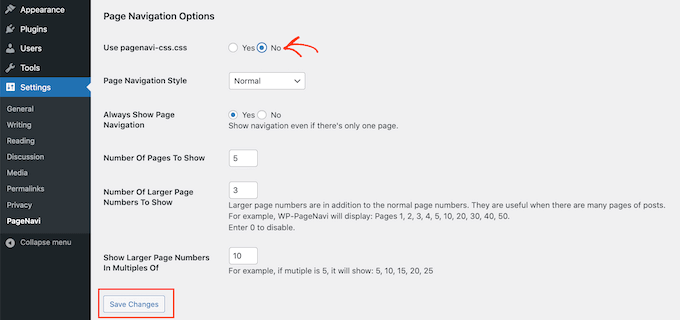
Ardından, Eklentiler ” Eklenti Dosyası Düzenleyicisi‘ne gidin.
Daha sonra ‘Düzenlenecek eklentiyi seç’ açılır menüsünü açabilir ve ‘WP-Page Navi’yi seçebilirsiniz. Bundan sonra, ‘Seç’e tıklamaya hazırsınız.

Sağ taraftaki menüde pagenavi-css.css dosyasına tıklayın.
Ardından, devam edin ve bu dosyadaki tüm kodu kopyalayın.
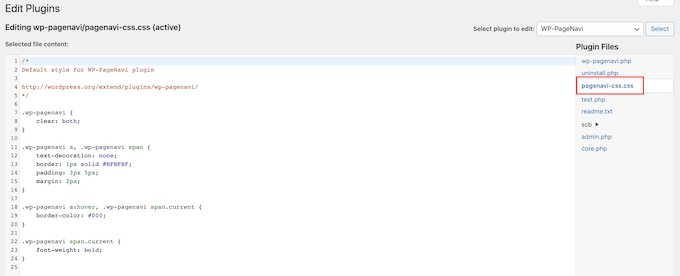
Ardından, Görünüm ” Tema Dosyası Düzenleyicisi‘ne gidin.
Sağ taraftaki menüde temanızın style.css dosyasına tıklayın.
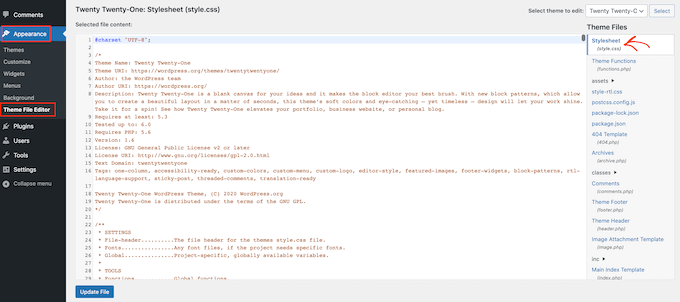
Artık pagenavi-css.css kodunuzu temanın style.css dosyasına yapıştırabilir ve değişikliklerinizi yapmaya başlayabilirsiniz.
Bir örneğe bakalım. İşte temanızın style.css dosyasına ekleyebileceğiniz sayısal sayfalama kodunun değiştirilmiş bir sürümü:
1 2 3 4 5 6 7 8 9 10 11 12 13 14 15 16 17 18 19 20 21 22 | wp-pagenavi { clear: both;} .wp-pagenavi a, .wp-pagenavi span { color: #FFF; text-decoration: none; background-color:#6FB7E9; border: 1px solid #B2D1E5; padding: 5px 5px; margin: 2px;} .wp-pagenavi a:hover, .wp-pagenavi span.current { border-color: #E9F2F9; background-color:#6FB7E9;} .wp-pagenavi span.current { font-weight: bold; background-color:#3C8DC5;} |
Aşağıdaki resimde, bu sayısal sayfalandırmanın sitenizde nasıl görüneceğini görebilirsiniz.
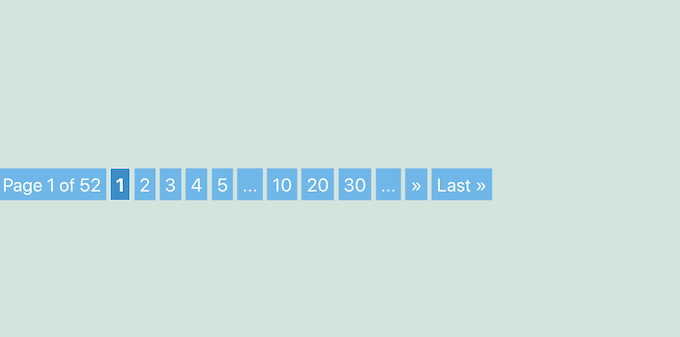
WordPress web sitenizde neyin en iyi göründüğünü görmek için farklı stilleri denemeye değer.
Sayısal sayfalandırmanızın nasıl göründüğünden memnun olduğunuzda, değişikliklerinizi kaydetmek için Dosyayı Güncelle düğmesine tıklayın.
Yöntem 2. WordPress Temanıza Manuel Olarak Sayısal Sayfalandırma Nasıl Eklenir
Diğer bir seçenek de kod kullanarak WordPress temanıza manuel olarak sayısal sayfalandırma eklemektir.
Birçok WordPress teması yerleşik ‘Daha Eski’ ve ‘Daha Yeni’ bağlantıları veya varsayılan sayısal sayfalandırma ile birlikte gelir. Örneğin popüler Astra teması, aşağıdaki resimde görebileceğiniz gibi arşiv sayfalarınıza otomatik olarak kendi sayısal sayfalandırmasını ekler.
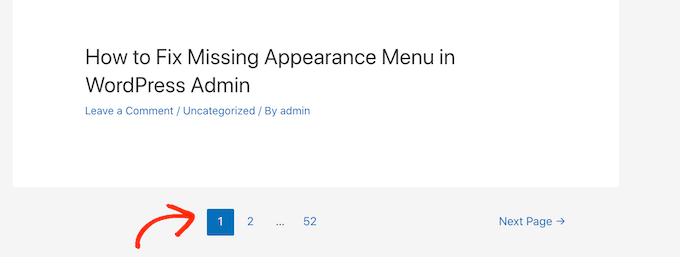
Bir temanın yerleşik sayfalandırmasını özelleştirmek için bu yöntemi kullanabilirsiniz. Örneğin, sitenize daha iyi uyması için stili değiştirebilirsiniz.
Sayısal sayfalamayı manuel olarak eklemek için temanızın functions.php dosyasını açın. Burada bir FTP istemcisi ya da WordPress hosting cPanel’inizin dosya yöneticisini kullanabilirsiniz. FTP kullanıyorsanız, sitenize FTP kullanarak nasıl bağlanacağınıza ilişkin eksiksiz kılavuzumuza bakabilirsiniz.
Sitenize başarıyla bağlandıktan sonra functions.php dosyasını açın ve aşağıdaki kodu ekleyin:
1 2 3 4 5 6 7 8 9 10 11 12 13 14 15 16 17 18 19 20 21 22 23 24 25 26 27 28 29 30 31 32 33 34 35 36 37 38 39 40 41 42 43 44 45 46 47 48 49 50 51 52 53 54 55 56 57 58 59 60 61 62 63 64 65 66 67 68 | function wpbeginner_numeric_posts_nav() { if( is_singular() ) return; global $wp_query; /** Stop execution if there's only 1 page */ if( $wp_query->max_num_pages <= 1 ) return; $paged = get_query_var( 'paged' ) ? absint( get_query_var( 'paged' ) ) : 1; $max = intval( $wp_query->max_num_pages ); /** Add current page to the array */ if ( $paged >= 1 ) $links[] = $paged; /** Add the pages around the current page to the array */ if ( $paged >= 3 ) { $links[] = $paged - 1; $links[] = $paged - 2; } if ( ( $paged + 2 ) <= $max ) { $links[] = $paged + 2; $links[] = $paged + 1; } echo '<div class="navigation"><ul>' . "\n"; /** Previous Post Link */ if ( get_previous_posts_link() ) printf( '<li>%s</li>' . "\n", get_previous_posts_link() ); /** Link to first page, plus ellipses if necessary */ if ( ! in_array( 1, $links ) ) { $class = 1 == $paged ? ' class="active"' : ''; printf( '<li%s><a href="%s">%s</a></li>' . "\n", $class, esc_url( get_pagenum_link( 1 ) ), '1' ); if ( ! in_array( 2, $links ) ) echo '<li>…</li>'; } /** Link to current page, plus 2 pages in either direction if necessary */ sort( $links ); foreach ( (array) $links as $link ) { $class = $paged == $link ? ' class="active"' : ''; printf( '<li%s><a href="%s">%s</a></li>' . "\n", $class, esc_url( get_pagenum_link( $link ) ), $link ); } /** Link to last page, plus ellipses if necessary */ if ( ! in_array( $max, $links ) ) { if ( ! in_array( $max - 1, $links ) ) echo '<li>…</li>' . "\n"; $class = $paged == $max ? ' class="active"' : ''; printf( '<li%s><a href="%s">%s</a></li>' . "\n", $class, esc_url( get_pagenum_link( $max ) ), $max ); } /** Next Post Link */ if ( get_next_posts_link() ) printf( '<li>%s</li>' . "\n", get_next_posts_link() ); echo '</ul></div>' . "\n"; } |
Bu kod, WordPress temanızda göstermeniz için hazır olan sayfa sayısını alır.
Sonraki adımlar temanıza bağlı olarak değişecektir.
Temanızda yerleşik bir varsayılan sayfalandırma biçimi yoksa, aşağıdaki şablon etiketini index.php, archive.php, category.php veya sayısal sayfalandırma göstermek istediğiniz herhangi bir sayfaya ekleyebilirsiniz.
1 | <?php wpbeginner_numeric_posts_nav(); ?> |
Bu kodu nereye eklediğinizin sayısal sayfalandırmanın web sitenizde nerede görüntüleneceğini etkileyeceğini unutmayın.
Tipik olarak, sayfalandırmayı arşiv sayfalarınızın altında göstermek isteyeceksiniz, bu nedenle genellikle şablon etiketini altbilgi kodunuza eklemek isteyeceksiniz.
Temanızda halihazırda ‘Eski Yazılar’ ve ‘Yeni Yazılar’ bağlantıları gibi bir tür sayfalandırma var mı?
Bu durumda, sayfalandırma kodunu bulmanız ve yukarıdaki kod parçacığı ile değiştirmeniz gerekir.
Örneğin, Ashe en iyi ücretsiz WordPress blog temalarından biridir ve arşiv sayfalarınıza ‘İlk’ ve ‘Son sayfa’ sayfalandırma bağlantılarını zaten ekler.
Bu yerleşik bağlantıları sayısal sayfalandırma ile değiştirmek için temanın templates/grid.php ve templates/blog-pagination.php dosyalarını düzenlemeniz gerekir.
Bu dosyaların her birinde aşağıdaki bölümü bulmanız yeterlidir:
1 | <?php get_template_part( 'templates/grid/blog', 'pagination' ); ?> |
Daha sonra devam edebilir ve bu satırı aşağıdaki kod parçacığı ile değiştirebilirsiniz:
1 | <?php wpbeginner_numeric_posts_nav(); ?> |
Kodu ekledikten sonra değişikliklerinizi kaydetmeyi unutmayın.
Bir sonraki adım, özel sayısal sayfalamanızı şekillendirmektir.
Ziyaretçilerin arşivde gezinmesine yardımcı olmak için, geçerli sayfa numarasını farklı bir renkle vurgulayacağız. Bunu yapmak için temanızın style.css dosyasını açın ve ardından aşağıdaki kodu bu dosyaya yapıştırın:
1 2 3 4 5 6 7 8 9 10 11 12 13 14 15 16 17 18 19 20 21 22 23 24 25 26 27 | .navigation li a,.navigation li a:hover,.navigation li.active a,.navigation li.disabled { color: #fff; text-decoration:none;} .navigation li { display: inline;} .navigation li a,.navigation li a:hover,.navigation li.active a,.navigation li.disabled { background-color: #6FB7E9; border-radius: 3px; cursor: pointer; padding: 12px; padding: 0.75rem;} .navigation li a:hover,.navigation li.active a { background-color: #3C8DC5;} |
Tüm bunlardan sonra, Dosyayı Güncelle düğmesine tıklayarak değişikliklerinizi kaydedin.
Şimdi arşiv sayfasını ziyaret ederseniz, sayısal sayfalandırmayı web sitenizde canlı olarak göreceksiniz.
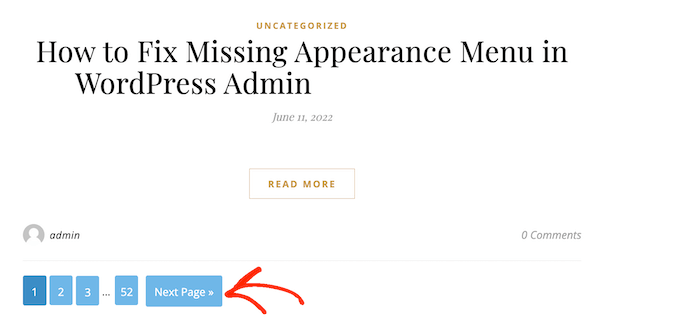
Umarız bu makale WordPress temanıza nasıl sayısal sayfalandırma ekleyeceğinizi öğrenmenize yardımcı olmuştur. WordPress ile çevrimiçi blog yazarak para kazanmanın yolları ve herhangi bir kod yazmadan özel bir WordPress temasının nasıl oluşturulacağı hakkındaki rehberimizi de inceleyebilirsiniz.
If you liked this article, then please subscribe to our YouTube Channel for WordPress video tutorials. You can also find us on Twitter and Facebook.





Tom
You really helpped me. Thanks !
Sam
Thanks very helpful
lucky cabarlo
how can i adjust the numbers to show in the custom numeric pagination
spongie
how do you limit the page number to say up to 2 only then show ellipsis?
krishma
can i use this plugin for custom post type
Astra
Of course mate. You just need to put this code into your page-custom.php
Med
Hello,
I found this very useful and I placed it to my new site. The problem is that it works perfect on the first page of the category, and after clicking on the “Next” link the url changes to /page/2/ but the highlighted page number is aways “1” and the content is always the first 10 articles (always in the first page).
I think there is something missing in my query:
<a href="”>
‘aligncenter’));
} else {
echo ”;
}
?>
Preeti Bhandari
how can i prevent whole page reload when clicking on next link, only want to refresh that particular section… Please help….
Luis Eduardo Braschi
Because “the goal is to replace the default Older and Newer pagination links at the bottom of archive pages” – and this is what “your” function does – “with easy to navigate page numbers.”.
Tony
Hi how do you get just the next and previous links only. thanks.
Barry
How can i use the wpbeginner_numeric_posts_nav(); for my Custom Post type?
I have replaced global $wp_query for
$args = array(
‘post_type’ => ‘my-cpt’,
‘meta_key’=>’cpt_detail’,
‘orderby’=>’meta_value’,
‘order’ => ‘ASC’,
‘paged’ => $paged
);
$cpt_query = new WP_Query($args);
and replaced $wp_query reference with $cpt_query but it doesn’t work
igloobob
Hi, did you ever figure this out please? I’m trying to get this working myself and struggling. Would appreciate your help very much if you got it working…
Ashley Michèlle
Using the ‘wpbeginner_numeric_posts_nav’ method, how would one change the navigation brackets? I’m not a huge fan of the ‘»’.
Thanks!
James George Dunn
Hello Ashley,
You can set a value in the brackets of get_previous_posts_link() and get_next_posts_link(). For example, get_next_posts_link(‘Next Post’) will show “Next Post” instead of the default “Next Page »”.
AmirMasoud
how can i change “Next Page” & “Previous page” text?
TimParkerRD
If you’re using the wpbeginner_numeric_posts_nav function, you can pass custom text to the get_next_posts_links() and get_previous_posts_link(), like so:
get_previous_posts_link(“Go Back”);
Daniel Ortiz
since Genesis Framework is not an open-source framework, are we allowed to use this code, commercially or not?( and are you allowed to distribute it?)
mr anon
thanks a lot
gosukiwi
Awesome, it works like a charm, I did some changes to fix my code though but the code is nice and well organized
Agarwalls
Thanks, Very helpful for me.
SJ
echo paginate_links( $args );
Why this one doesn’t do the job? I’m just curious
SJ
Why this one doesn’t do the job? I’m just curious
Baba agba
I tried it and its not working for me. Can you paste a simple example of your “paginated posts” code here
Nick
Has anyone had any luck getting this working with a custom WP_Query? It works perfect with the standard loop, but does not show up with a custom query. Any help would be great.
Thanks.
Marx
Have you tried the custom query examples noted from the codex?
http://codex.wordpress.org/Function_Reference/paginate_links
Hope that helps.
SJ
Well this one doesn’t work for me Don’t know why
Don’t know why
Mufaddal
Thanks so much, I tried your solution it worked for me.
Timberland
You have 2 options to do that, First is to use query_posts instead of Wp_Query
or the Second is to name your custom query “wp_query” as $wp_query = new WP_Query( $args );
important part in both approaches is to pass the ‘paged’ => $paged argument in your query otherwise won’t work,
//////////////////////////////////////With Wp_Query
$args = array( ‘cat’ => 3, ‘paged’ => $paged );
$wp_query = new WP_Query( $args );
if ( $wp_query->have_posts() ) :
while ( $wp_query->have_posts() ) {
$wp_query->the_post();
get_template_part( ‘content’, get_post_format() ); }
else :
echo “No post to show”;
endif;
wpbeginner_numeric_posts_nav();
wp_reset_postdata(); }
//////////////////////////////////////With Query_Posts
$args = array( ‘cat’ => 3, ‘paged’ => $paged );
query_posts( $args );
if ( have_posts() ) :
while ( have_posts() ) {
the_post();
get_template_part( ‘content’, get_post_format() ); }
else :
echo “No post to show”;
endif;
wpbeginner_numeric_posts_nav();
wp_reset_query(); }
[Hope that helps]
DavidCWebs
Try this native WP function: http://codex.wordpress.org/Function_Reference/paginate_links There’s an example on that codex page showing how to use it with WP_Query.
Hope this helps
Tim
Do this pagination have page number limits or does it automatically detect when more pages are required? Works really nicely
Akash Funde
Thanks for sharing this it helps a lot
Thanks you so Much
adrian
I’ve been using this successful for search results, archives, categories.. but it’s not working for tags. I suspect it could be a permalink issue. The first page works fine, but subsequent pages return 404s. Should this work for tags by default.?
Bubu
search results, archives are ok but in categories same error here. the first page is ok, second page return with 404.
need some help to solve this issue thx
Caroline
Thanks for this, it came in real handy making pagination Foundation framework-ready.
Hiro
I added this to my site and it shows up properly but doesn’t display the proper content on page 2. Tried it both manually and with the plugin. Both times, the pagnation links appear, and when i click to go to page 2, the url changes to page 2 but the content on the page shows only content from page 1 (or index). Please advise
Steve
I am new to Genesis but you say if we are using it that the function is already in there but when I tried adding the php to the hooked area, nothing would display so… I added the above code to my genesis functions.php and added the php call to my hooked area and now the pagination displays but it does not work. When I click the 2nd page, it just reloads the current page.
WPBeginner Support
please contact genesis support
Admin
Tyler
Does this work for wordpress.com sites? I have this blog that is set up via wordpress.com, not the installed version and I need to add pagination for the blog. Is there a way to do that? Thanks for any future help!
WPBeginner Support
No this tutorial is mean for Self hosted WordPress.org sites. As a WordPress.com user you can not directly edit themes.
Admin
Crear Cuenta Outlook
thank you so much
Rajavenkateshwaran
Am facing issues when i use the function within the custom page template. I created a custom page template to loop 4 of the posts, this function works well in Homepage and it doesnshow any sign of navigation links in page template.
Best Regards,
Raja
WPBeginner Support
If you are using a custom WP_Query then please check pagination parameters.
Admin
aklavya
thanx ……………… this code is very helpful
Dejan
Thank you for this code of pagination it is working with WP 3.7.1
Eli Overbey
Any thoughts on how to get archived pagination on Category Blog Page? (in Genesis)
I was able to create a page entitled ‘counseling-blog’, so now we have a Category Blog page at
But here’s the problem… No pagination. The /blog/ has the pagination from Genesis WP. All we have on that new Category Page page is:
”
There is no rel=”next” or rel=”prev”… Any thoughts on how to add next and prev to the Category Blog Page?
I thought the page would add those tags because the template is set as blog.
Big V
Nice post, but I’m having issues with /page/2 not working in my custom theme. Any advice?
Jeremy
WordPress has a core function for doing this.
http://codex.wordpress.org/Function_Reference/paginate_links
Gohar ul Islam
I am searching code (or any kind of help) which uses paginate_links in Wp_query. Do u have any code like this?
Dmitry
Thanks!
Mzer Michael Terungwa
I tried to implement this pagination on the single.php page but it did not show up. Is this only for theme’s index.php, archive.php, category.php, and any other archive page template?
Michael
It appears that Multiple Posts Pagination is quite different from single post pagination and would require different template tags to create them.
WPBeginner Support
Yes this code is only for index and archive pages.
Admin
Felipe Gangrel
Awesome. Thanks a lot!!!
Talha
Great code, thanks bro
Shaghayeggh
Thank you very very much
Marko
Hi,
thanks for great tutorial!
I had to add ul in front of every li in style.css, otherwise this worked perfectly.
(.navigation ul li a,) etc…
elvinson
i have installed wp-pagenavi plugin, but it was not showing in archives , so i have used your coding manually it is working well. Thanks.
Don
what about pagination for a single post that contains numerous pages .. i.e.- this is about A SINGLE POST – that was too long and had to be divided into multiple pages ! … the wp codex for this type of single post pagination is done with the command ( ) … unfortunately none of the plugins out there provides a good solution for this type of pagination ….. or they simple avoid it all together … the wp-pagenavi mentionned it very briefly…. but does not work for single post pagination on 95 % of the wp themes out there….
if there is such a plugin that provides a good alternative for wp_link_pages with good styling and other options for single post pagination …. please share !!!
Editorial Staff
Genesis theme has that option. We are using that on our site http://list25.com/
Admin
Chinmoy Paul
Thanks for sharing this. I will use this in my next project.
Robert Smith
Thanks for this guys! Been looking for a simple solution like this all evening and this was gold!!
Keep up the great work on your site, as it is a regular resource of mine
Thanks,
Rob
Arilton Freitas
To me, the best way to include numeric pagination in WordPress is use the paginate_links() function. Simple and core-based.
http://codex.wordpress.org/Function_Reference/paginate_links
Editorial Staff
Didn’t even know that existed. Thanks for pointing this out.
-Syed
Admin
Mattia
Indeed this is awesome, but… The pagination always appear, also if not needed… Ho do you prevent this?
If mu limit is 10 posts per page, but I only have written 5, the paginations appears and sends me to an empty “page 2″… ;(
Mattia
I checked another of my sites and this error doesn’t appear. In this late site I am building, strangely pagination appears also if not needed! Does someone know which could be the cause? Many thanks!
Jacob
WordPress already has this baked in with a function called paginate_links (http://codex.wordpress.org/Function_Reference/paginate_links).
Upendra Shrestha
Hi, Previously I used wp pagenavi plugin in genesis framework. But it didn’t work with the framework. After adding the code “”, it just worked. I didn’t realize that I had to add this code.
Thanks.
Alex Sancho
and what about the WordPress function paginate_links? http://codex.wordpress.org/Function_Reference/paginate_links
Connie
for those who want to style differently but are not CSS-savy, there are at least 2 additional plugins available:
WP Visual Pagination, http://wordpress.org/extend/plugins/wp-visualpagination/
or
WP PageNavi Style , http://wordpress.org/extend/plugins/wp-pagenavi-style/
Cheers,
Connie
Editorial Staff
Thanks for letting us know Connie.
Admin
Azim
Isn’t it going to be a heavy SQL query, esp. on blogs with lots and lots of posts? I had to get rid of such pagination on one of my projects (containing over 10K posts), because hoster claimed it consumed too much of a CPU and SQL resources. Basically, what it did is selected ALL posts (over 10K, remember?) and then just divided them into multiple pages with 20 (or whatever you specify in admin) posts per page…
Editorial Staff
WordPress is dividing the posts in those pages to begin with using the WP_Query posts_per_page parameter. All this query is doing is looking at those pages and creating a numeric display. I’m sure there was more going on that your host didn’t bother explaining.
-Syed
Admin